International PPC: The Complete Guide
- December 15, 2023
- Knowledge Base
- 0 Comments

When you want to reach a global audience, turn to international PPC.
PPC, or pay-per-click, campaigns have long been an effective way to get in front of your target buyer and drive traffic to your site. When it comes time to expand into a new market or reach customers on the other side of the world, that’s when you need to employ an international PPC strategy.
Below, let’s go over everything marketers need to know about international PPC campaigns: how they’re different from domestic, how to create them, and some best practices and examples to give you actionable inspiration before your next campaign.
Table of Contents:
What is international PPC?
International PPC, or pay-per-click, is a search engine marketing strategy used by advertisers who want to reach an international audience. PPC ads are displayed at the top of the search engine results page (SERP) when users search for certain keywords or phrases.
Advertisers can target these keywords and use their ads to direct people to their website or landing page. PPC means advertisers will pay a fee whenever someone clicks on their ad.
International PPC is an effective way to reach customers around the world, whether you’re expanding into new markets or your primary customer is in a different country.
Because these ads are usually seen in search engine results on Google or Bing, advertisers create these campaigns on Google Ads or Microsoft Ads. You can also create PPC ads for social platforms like Meta or ecommerce sites like Amazon.
How International PPC Campaigns Differ From Domestic
If you’re familiar with PPC, you likely understand how to create ad campaigns for a local or domestic market. However, international PPC campaigns are different when it comes to preparation, ad creation, and distribution.
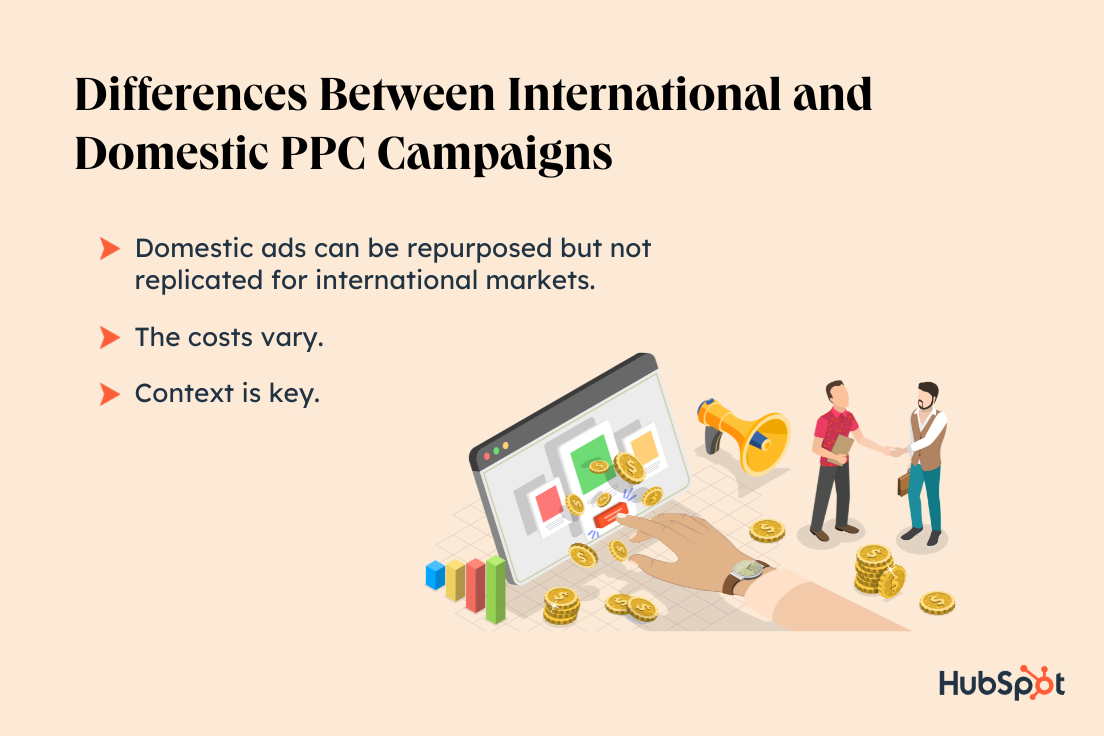
Here are the main differences between international and domestic ad campaigns and what you can do to bridge the gap for your audience, according to international PPC experts.
Domestic ads can be repurposed but not replicated for international markets.
It can be tempting to take a successful domestic PPC ad campaign and distribute it to all of the new markets you want to target. But simply replicating your ads won’t yield the results you’re looking for.
“One-size-fits-all templates don’t work,” says Flavio Rodrigues, an SEM consultant who runs the consultancy, Digital Sardine. “There are differences in languages and dialects, currencies, user behaviors, and even payment methods,” he adds.
“US companies sometimes underestimate the diversity and differences among European countries, as they may be used to dealing with one large territory, one language, one currency, and one approach.”
If you want to build international PPC ads, it’s best to start from scratch in terms of strategy. “That’s not to say that you need to rebuild all of your ads and landing pages,” says Brent Stirling, a performance marketing consultant who formerly ran paid social ads at Shopify.
“But if you‘ve got screenshots of a SaaS product that are all in English and you drop those into the Vietnamese market with some machine learning translated copy, it’s not going to go as well as you hope.”
The costs vary.
Another significant distinction between running international and domestic ads is the cost per click (CPC), “which is typically lower outside the US due to the high competitiveness of the US PPC market,” Rodrigues points out.
As you’re creating your domestic ad spend budget, keep in mind what your average CPC is for your current campaigns so you have a baseline to compare with.
In addition to your ad spending, you may also see differences in how your international customers spend.
“Credit card penetration rate in Germany is far lower than the US, for example,” according to Stirling. “If people can only pay for your product with a credit card, you’ll see an inflated customer acquisition cost and not understand why.”
Context is key.
When creating for international markets, be aware of the differences in language, currencies, purchasing habits, and behaviors compared to the market you’re already familiar with.
“Context is one of the hardest things to figure out,” says Stirling. “It’s not just about the ads you run and how they look and feel, but how different countries operate too.”
While context is critical, it’s also something that’s hard to pinpoint until you’re deep in the process. If you’re new to a certain market, see how others are running ads in those countries before you set off to create your own.
“Figure out if there‘s any difference in how people advertise in different countries or how people use the platform you’re running ads on,” suggests Stirling.
He recommends using searchable database tools like Meta Ad Library and Google Ads Transparency Center to get a sense of what your competitors are doing in the markets you want to run ads in.
How to Create International PPC Ads
- Determine your target location.
- Identify target keywords.
- Determine your CPC budget.
- Choose or build your landing pages.
- Build your ad.
Ready to launch your campaign in an international market? Follow this step-by-step guide to create your next international PPC ad.
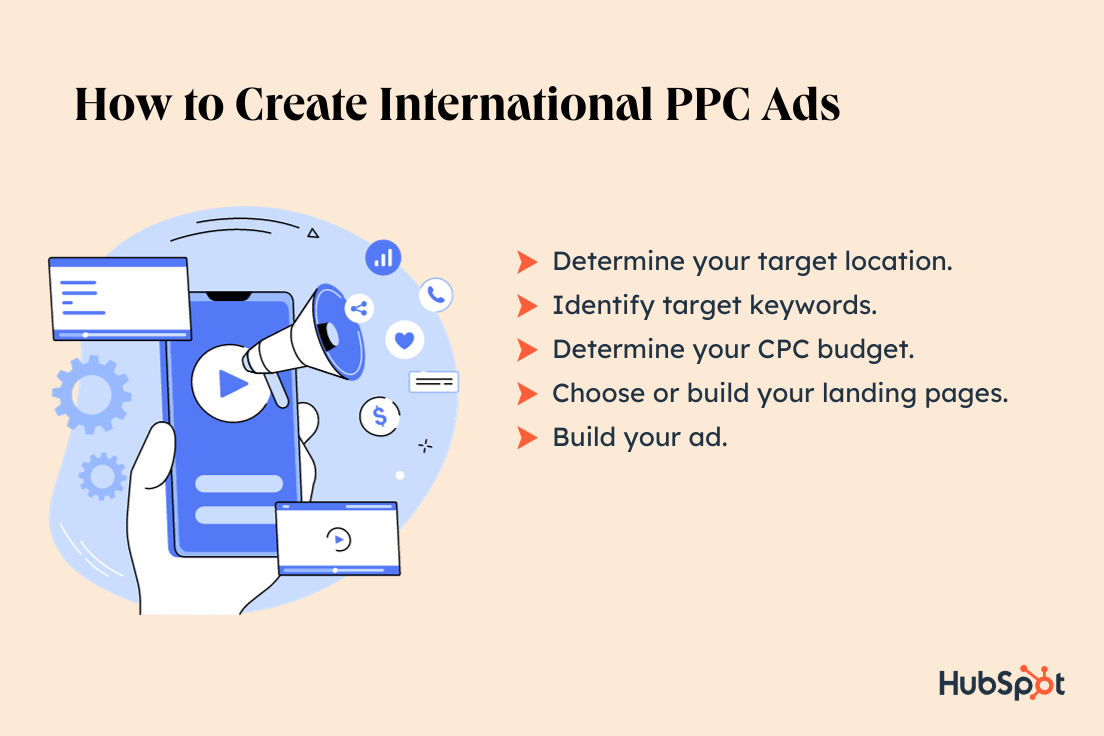
1. Determine your target location.
Geographic targeting is key to any PPC campaign, but it’s especially important for an international ad.
Use your PPC management tool to decide exactly where your target location is. You may know that you want to target customers in the UK, for example. But do you want to reach people in bustling London or the English countryside?
Every region within a country is different so identify exactly who your target customer is when determining your target location.
While localization is important, it’s crucial to do your research into cultural context and audience behaviors so you can understand what actually resonates with your customer — and what doesn’t.
“To run ads in France, you don’t need to have someone in a beret with a baguette,” notes Stirling.
“In some cases, I’ve actually seen full localization of every aspect of a customer journey, from ad to landing page, go really poorly in places like China, Japan, India, France, Germany, and Italy, especially in the SaaS space.”
2. Identify target keywords.
Use Google Keyword Planner or a tool like SEMRush to identify the keywords you want to target in your international PPC ads.
When identifying your target keywords, remember that certain keywords may not directly translate into the international target market language. To avoid saying something offensive or just plain wrong, invest in translation services.
If you don’t have the resources for a translation service, at the very least, run your keywords through Google Translate. Keep in mind that direct translations don’t always work, so if possible, it’s better to work with a person or service to get context behind the keywords and language of the market you’re targeting.
3. Determine your CPC budget.
As we mentioned earlier, depending on where you’re running your campaigns, the cost will likely be different from what you’re used to.
For example, English-speaking markets are typically the most expensive to advertise in, so you may want to adjust the budget if you’re targeting a different market. You can always modify your budget and reallocate spending once you get started and have a better idea of what your CPC and acquisition costs are.
4. Choose or build your landing pages.
Next, decide where to direct people who click on your ad. Search ads are designed to drive traffic to your website, whether that’s your homepage or a specific landing page — it depends on your goals.
You can either optimize an existing page on your website to match the ad or build a new landing page from scratch.
The key is to make sure everything on the landing page aligns with the ad campaign you’re running.
If your ad headline promises a quick and easy way to book a flight, the last thing someone wants is to click through multiple steps to find the booking page.
Make sure your ad and landing page are aligned when it comes to messaging, content, and calls to action.
5. Build your ad.
While you want to be mindful of the markets you’re running your ads in, consider using more general visuals and weaving localization in where it matters, like in the ad copy and currencies.
Figure out what your ad copy and landing page creative will be and how it all speaks to your international audience. “Making sure every element is localized, or at least palpable, for an international market is key,” says Stirling.
As you build you ad, refer to other international ad campaigns you noted during your research. Keeping the standard PPC ad structure in mind — headline, display text, URL — weave in the localization elements for the new market you’re targeting.
PPC Landing Page Examples
To get a better idea of what an effective PPC landing page looks like, let’s take a look at a few international PPC search ads and how their landing pages match up.
Hotels.com
It should come as no surprise that the travel industry excels in running international PPC campaigns.
When you have a global brand that reaches customers around the world, you need to be skilled at localization and running multiple campaigns at once.
One example from the travel industry comes from Hotels.com. The hotel booking site uses search ads to promote its easy reservations process, top-rated hotels, and positive customer reviews to travelers from around the world.
This particular ad targeted the French market. Not only did it use French language for the ad copy, but it specifically highlighted hotels in different French cities, from Lyon to Marseille.
If you click the ad, you land directly on the Hotels.com booking page. The landing page is in French which is in line with what you’d expect when clicking on the French search ad.
Everything about this international ad is clearly optimized and localized.
Bluepillow
Another travel industry example comes from Bluepillow, a global vacation rental search engine.
The Milan-based company uses international PPC ads to target global customers who either want to book a short-term rental or list their home for rent.
Below is a PPC ad from Bluepillow that’s written in French and promotes savings and deals for rentals in Paris.
The search ad leads directly to the landing page below which is the booking page for rentals and hotels in Paris. The prices are automatically displayed in the country’s currency, the euro.
Shopify
Shopify is a leading ecommerce tool used by millions of businesses around the world. This means they need a strong international PPC strategy to reach global customers.
Below is an example of one of Shopify’s search ads promoting its global ecommerce solutions.
The search ad directs users to this landing page. The messaging of the landing page aligns with what someone would expect after seeing the ad from the search results.
It describes what someone who’s conducting international ecommerce needs out of their website, and all of the globally-minded solutions that Shopify offers.
Amazon
Global online retailer, Amazon is also a major player in international PPC.
An example of their strategy can be seen in the two PPC ads, below. Both ads are created to promote Coca-Cola listings on Amazon but they target different markets. The first one is designed to target the US market.
The ad’s headline displays the official Coca-Cola page on Amazon, which it directs to when you click it.
The rest of the ad copy reminds shoppers that Amazon has kitchen and dining supplies from hundreds of popular brands, assuming that the person seeing this ad may need more groceries or supplies in addition to the beverage.
Here is the second search ad which targets the Mexico market. The ad is written in Spanish and directs to a listing for the beverage on Amazon Mexico. What’s different about this ad compared to the US version is the messaging.
Instead of mentioning any other Amazon products or categories, this ad focuses solely on a limited-edition beverage from the brand. Why, you may wonder?
Coca-Cola is the most consumed beverage in Mexico, so one can assume that a limited edition product would pique the interest (and increase the click-through rate) of some of Coca-Cola’s biggest fans.
PPC Tools
HubSpot’s PPC Campaign Management Template
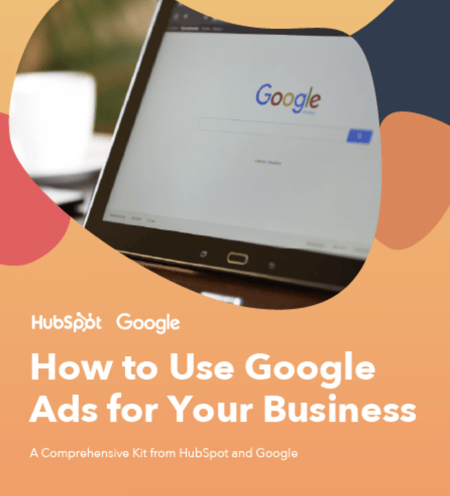
This free template from HubSpot acts as a checklist to ensure you don’t miss any key elements for a successful ad campaign.
Following this template can be especially useful if you’re new to creating PPC ads as it provides a descriptive breakdown of what your ad copy should look like.
For example, it outlines how many characters are needed for each ad headline or display URL and includes a chart for you to track key campaign metrics such as impressions, cost-per-click (CPC), and conversions.
Simply plug in your ad campaign information and track relevant metrics to measure your results.
Best for: If you’re a beginner, use this free template to plan and track a full-funnel international PPC campaign from start to finish.
Google Ads Editor
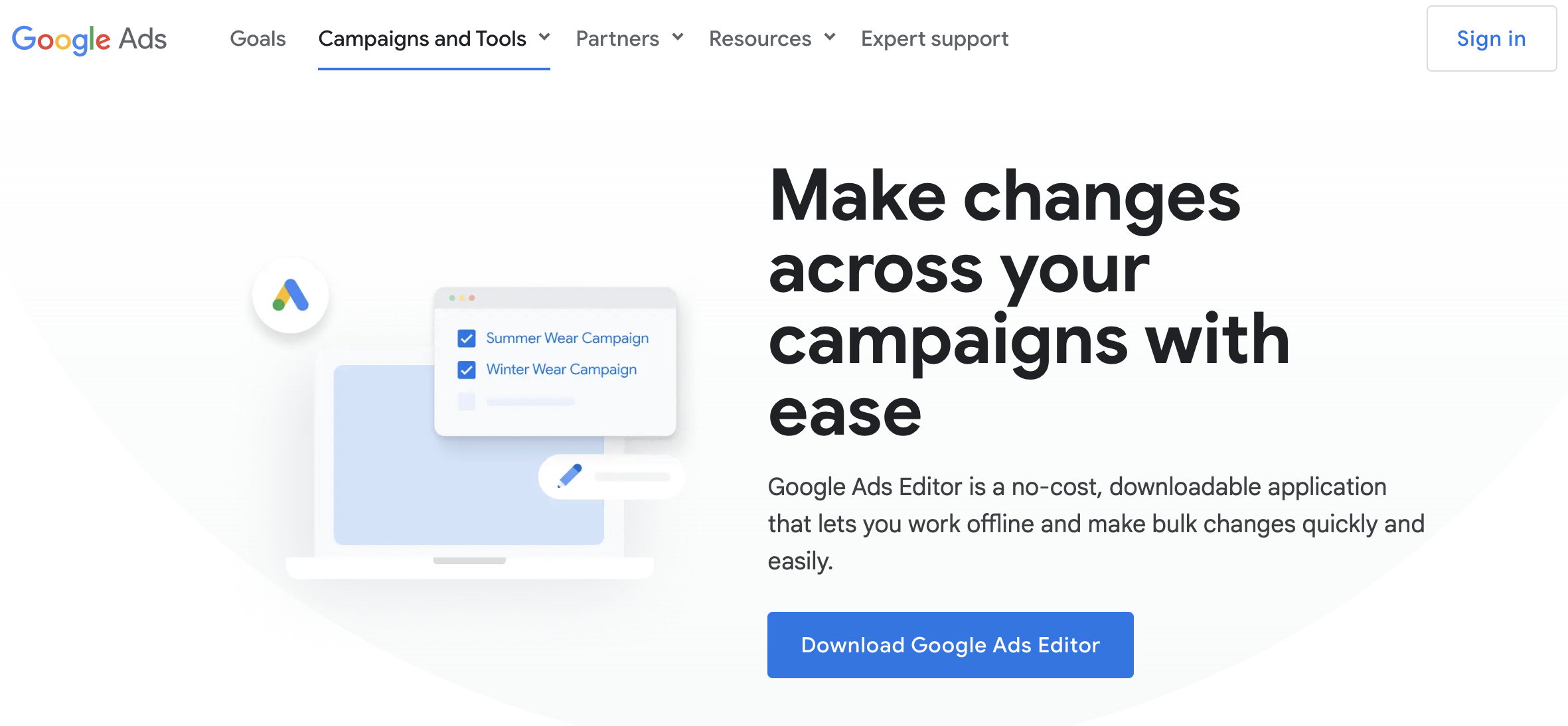
Google Ads Editor is a free tool to manage and edit your Google Ads Campaigns wherever you are. You can modify your campaigns, make bulk changes, and even work offline so you can adjust your ads as quickly as needed.
Best for: This free tool is an essential part of PPC campaign management.
SEMRush
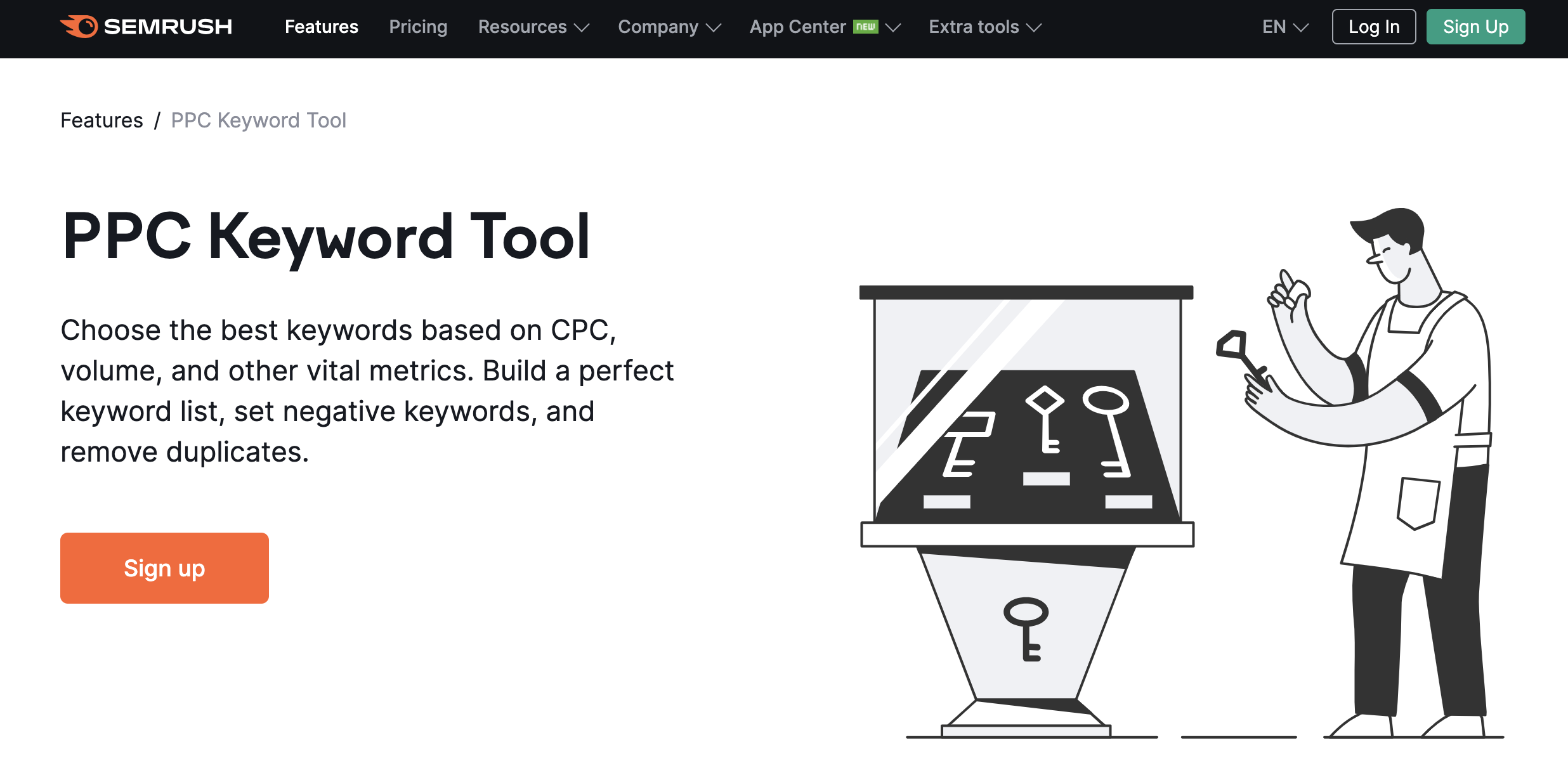
Keywords are the most important element of any PPC campaign, but you need to make sure you’re targeting the right ones to see results.
Use SEMRush to identify and collect target keywords for your campaigns.
You can also manage those lists of keywords (because we all know how challenging it can be to keep track of those keywords when you have multiple campaigns going!) to remove duplicates and set negative keywords.
What we like: You can use SEMRush to identify, track, and manage both organic and paid keywords.
Wordstream’s PPC Software
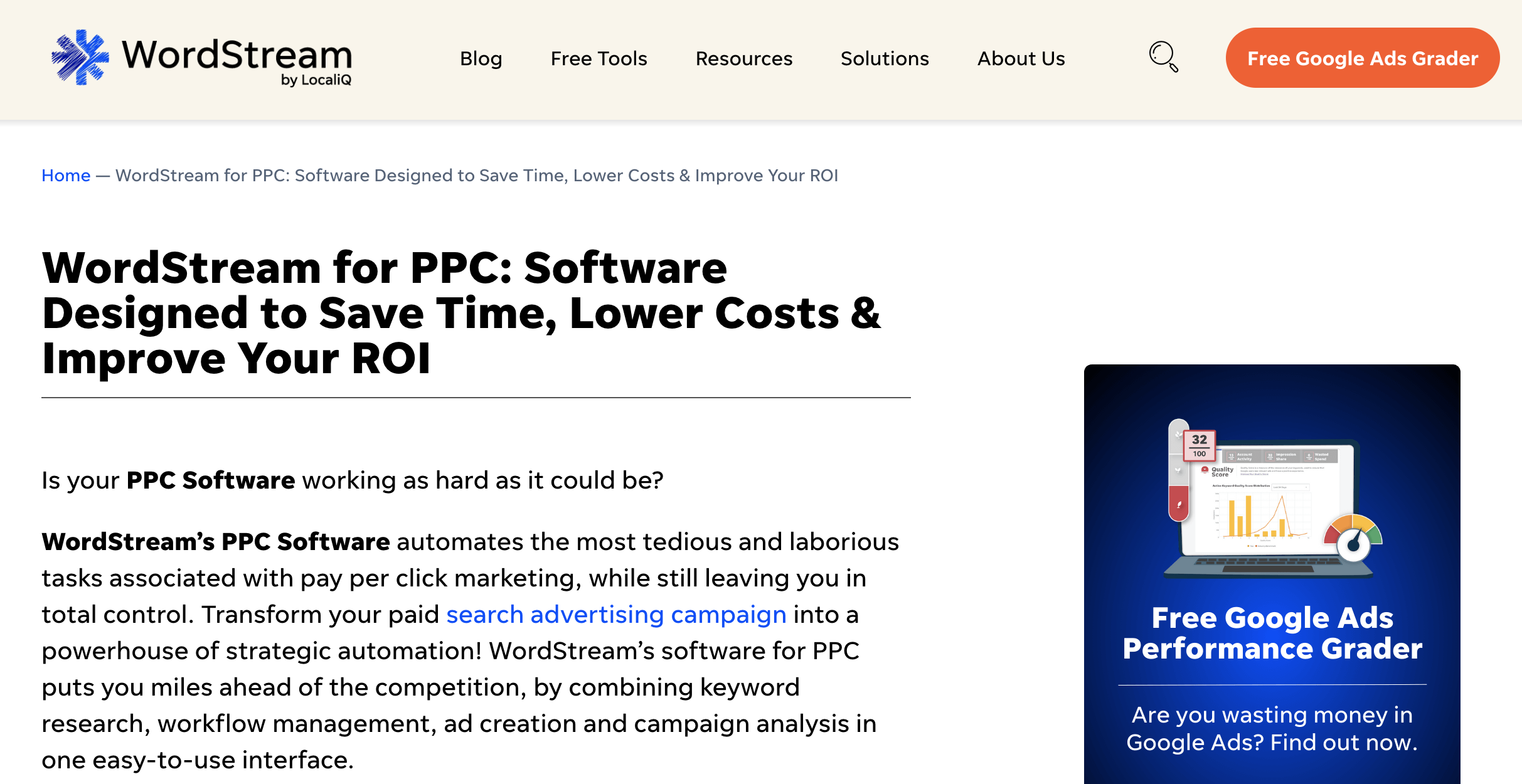
Wordstream makes it easy to manage every aspect of your PPC campaigns using automation.
Using this PPC software, you can conduct keyword research, improve workflow management, create ads, and analyze your campaigns in one easy-to-use interface.
Plus, Wordstream offers a seven-day free trial, making it ideal for small businesses with limited resources (or time) to waste.
Best for: Small businesses that want to make sure they’re getting the most out of their PPC strategy. Wordstream also offers a free GoogleAds Performance Grader so you can get an overview of how your campaigns are performing, especially in relation to your competitors.
International PPC Best Practices
- Use native language.
- Get specific with your ad groups.
- Experiment with campaign settings to optimize results.
- Build with international in mind.
To create effective paid campaigns for an international audience, follow these four best practices recommended by PPC experts.

1. Use native language.
The number one thing to remember when creating global ad campaigns is to use the native language of your target market.
While this may sound like a no-brainer, it can be easy to overlook details if you don’t keep international in mind throughout the entire campaign process.
Make sure that not only does your ad copy use native language, but that your landing page is a fully connected user experience.
This means the landing page should use the same language as the ad and the product experience should match your target audience, from their behaviors to currencies.
Another best practice to keep in mind when it comes to using native language is to avoid using direct translations. “Ads and the experience that follows are a creative endeavor,” says Stirling. “Your brilliant English copy, if translated poorly, is going to result in less than stellar results.”
To avoid confusing messaging and increase the chance that your ad will convert to a new market, Stirling recommends transcreation.
“Having access to a solid transcreation team or service that can take your English copy and not directly translate it, but transcreate it so it makes sense in the context of another language gives you a huge leg up,” he says.
Another way to create effective copy for international campaigns is to be proactive with the language barriers.
If you already know which international markets you want to target, you can prepare by working with native-speaking copywriters in those regions *before* you distribute your ad.
This can be a great way to understand the market and the audience you’ll be speaking to and get more context behind the message.
2. Get specific with your ad groups.
Effective PPC campaigns should have a series of ads within the campaign. Think of these as a way to A/B test everything from the headline to the landing page.
For international PPC ads, consider getting even more specific within your ad groups. Rodrigues recommends structuring campaigns with consideration for both locals in their home countries and locals living abroad.
“Consider factors like language and currency preferences for users in a specific location,” says Rodrigues. “If you target only English-speaking users in the UK, you may miss out on millions of expats, so consider targeting users in French, Spanish, German, and other languages.”
3. Experiment with campaign settings to optimize results.
All successful PPC campaigns require continuous testing and optimizing, and international ads are no different. Always test and refine your ad creative, copy, targeting, and bidding strategies.
As you learn more about the international market you‘re targeting, you’ll pick up on things that may be working and what’s not. Take what you learn, apply it to your campaign settings, and track the results.
4. Build with international in mind.
If you’ve already found success when creating domestic PPC ads, then you’re halfway there. You already know how to structure, create, and budget for ads that convert. Now take that knowledge and build for a broader audience.
“The tried and true method for me is to build with international in mind, using product screenshots that are language agnostic, then test those ads in English-speaking markets with English copy where you’re already advertising,” says Stirling.
“These are typically the most expensive places to advertise, so if you can win there, you can win everywhere. Take your winners, transcreate your copy and landing pages, and launch internationally.”
Build Your Own International PPC Strategy
If you’re marketing to customers around the world or in a specific global region, having an international PPC strategy is essential for your marketing team.
By using these international ad best practices and tools, you’re setting up your team for global success.



 No, it’s not. (I’ll explain below) Will SEO exist in 10 years?
No, it’s not. (I’ll explain below) Will SEO exist in 10 years? 

